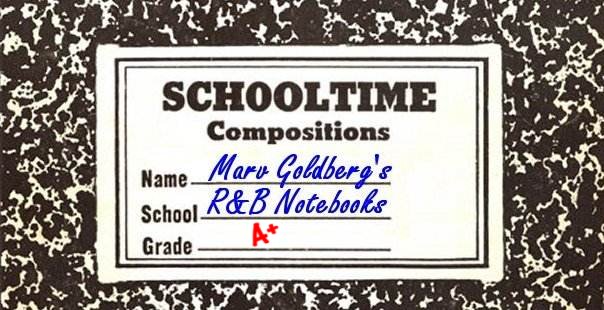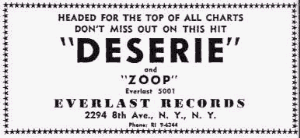
The Charts
By Marv Goldberg
Based on interviews with Stephen Brown
and Leroy Binns
© 2000, 2009 by Marv Goldberg

There's no getting around it - when you think of the Charts, you think of "Deserie", you think of soaring tenors, you think of raw New York street corner sound. This is the story of the Charts.
 The neighborhood of 115th Street and Lenox Avenue in Harlem was packed with groups: the Channels, the Bopchords, and the Harptones, just to name a few. Hallways were the classic place to rehearse and perfect the sound that each group tried to call its own. In 1956, a group of teenagers, ranging in age from 13 to 17, practiced in the Stephen Foster Center and called themselves the Thrilltones. They were: Joe Grier (lead), Stephen Brown (first tenor), Glenmore Jackson (second tenor), Leroy Binns (baritone), and Ross Buford (bass). Their inspirations were the Dells, Flamingos, Moonglows, Drifters, and the local Harptones.
The neighborhood of 115th Street and Lenox Avenue in Harlem was packed with groups: the Channels, the Bopchords, and the Harptones, just to name a few. Hallways were the classic place to rehearse and perfect the sound that each group tried to call its own. In 1956, a group of teenagers, ranging in age from 13 to 17, practiced in the Stephen Foster Center and called themselves the Thrilltones. They were: Joe Grier (lead), Stephen Brown (first tenor), Glenmore Jackson (second tenor), Leroy Binns (baritone), and Ross Buford (bass). Their inspirations were the Dells, Flamingos, Moonglows, Drifters, and the local Harptones.
A group needs a manager and the Thrilltones turned to singer and soon-to-be-bandleader Les Cooper, tenor with the Empires. Cooper told them that their sound was good, but their name had to go. He said: "You kids are so young, what do you know about thrilling?" Since the desire of all singers in the neighborhood was to have a song on "the charts", this seemed like a perfect name.
The newly-christened group took one of their songs to the Apollo Theater's Amateur Show, and immediately got into trouble. "Deserie", unlike most other songs, has no bridge between the second and third verses. This worried bandleader Reuben Phillips when he rehearsed them, but by the time of the show, since there were so many acts, it was forgotten. Part of the band started playing a bridge anyway, which threw everything off. The result: the Charts were booed off the stage. (It might be worth noting that "White Christmas", possibly the best-selling song of all time, doesn't have a bridge either.)
While many of the groups in the neighborhood wound up on one of Bobby Robinson's labels (Red Robin, Whirlin' Disc, Fire, Fury), Les Cooper took the Charts to see Bobby's brother, Danny, who had
an electronics store on 124th and Lenox. Robinson, who wanted to start his own label, had a back room in the store with a piano that the group could use to rehearse.
Danny Robinson issued ten of the Charts' songs on his Everlast label. "Deserie", of course, is the one most people remember, but many of the others (including "Dance Girl", "Why Do You Cry", "You're The Reason", and "All Because Of Love") are also great examples of the classic New York street corner sound.
 "Deserie" and "Zoop" became the Charts' first release (as well as being Danny Robinson's first issue on Everlast), appearing in May 1957. They were reviewed (both sides good) on June 10, along with the 5 Satins' "To The Aisle", the Bobbettes' "Mr. Lee", the Palms' "Edna", the Strollers' "Go Where Baby Lives", the Tune Weavers' "Happy, Happy Birthday Baby", and the Matadors' "Have Mercy Baby".
"Deserie" and "Zoop" became the Charts' first release (as well as being Danny Robinson's first issue on Everlast), appearing in May 1957. They were reviewed (both sides good) on June 10, along with the 5 Satins' "To The Aisle", the Bobbettes' "Mr. Lee", the Palms' "Edna", the Strollers' "Go Where Baby Lives", the Tune Weavers' "Happy, Happy Birthday Baby", and the Matadors' "Have Mercy Baby".
On June 28, the Charts began a week's engagement at the Apollo Theater, as part of a Dr. Jive show. Also on the bill were Donnie Elbert, Ann Cole, the Velours, the Heartbeats, the Jesters, the Sensations, Roy Brown, and Charlie & Ray. Presumably on this occasion the band had less trouble following them.
The week of July 7 found "Deserie" a Tip in New York. In August, it was reported doing well in Chicago.
On the strength of "Deserie", the Charts played local clubs, as well as out-of-town gigs: the Poconos, the Catskills, Philadelphia, Boston, D.C., and Baltimore. When they were on the road, Joe Grier would sing lead for about two days, until his voice gave out (remember, there were usually many performances each day), at which time Stephen or Leroy would assume lead chores. Since Danny
Robinson was too busy to accompany the Charts on their touring, he assigned John Bowden as their road manager. They appeared up and down the East Coast, and as far west as the Regal Theater in Chicago.
The Charts were back at the Apollo the week beginning September 13, 1957. This time they were part of a show featuring Dinah Washington, Slappy White, Ocie Smith, and the Hines Kids (Gregory and Maurice).
Leroy tells the story of how the Charts were called on the carpet before that Apollo show. At an engagement at the Howard Theater, they were fooling around with the drums backstage before the show. Joe Grier accidentally knocked over a tall light pole, and only the good luck that it caught on some cables prevented it from tearing through the theater's movie screen! When they got to the Apollo, stage
manager Honi Coles sat them down and made sure they knew that this would be unacceptable behavior at the Apollo.
In October, Everlast released the Charts' second record: "Dance Girl"/"Why Do You Cry", with King Curtis present on the session. However, it doesn't seem to have been reviewed.
In April 1958, Everlast issued "You're The Reason"/"I've Been Wondering", which was reviewed on April 28. Other reviews that week went to the Dominoes' "Jennie Lee", Johnny Otis' "Willie And The Hand Jive", Mickey & Sylvia's "Bewildered", Screamin' Jay Hawkins' "Alligator Wine", the Solitaires' "No More Sorrows", and the Spaniels' "Great Googley Moo".
Later in 1958, Everlast released "All Because Of Love"/"I Told You So". When this failed to take off, their fifth and last record was issued (also in 1958): "My Diane"/"Baby Be Mine". There was no action on this one either, and this was pretty much the end of the classic Charts group.
In 1958, Joe Grier went into the service. (When he came out, he joined Les Cooper's band, the Soul Rockers, as a sax player [Les played keyboards], and is heard on Les' 1962 hit "Wiggle Wobble".) Over time, Glen Jackson and Ross Buford just drifted away. Stephen Brown and Leroy Binns, determined to keep it all going, hooked up with John L. Bruce (first and second tenor) and Joel "Joey" Gray (second tenor) and continued the Charts into the 1960s. Whereas the voice parts of the original five Charts were fixed, this aggregation would switch them around as necessary.

 However, John L. Bruce didn't last too long and, by the time they appeared at the Apollo as part of an Alan Fredericks Old Goldies Show the week starting July 28, 1961, he was gone. They got a quick replacement in Mack Starr (the new name of Julius McMichael, former lead of the Paragons), but he was only with them for that engagement (which also starred the Cleftones, the Teenagers, the Cadillacs, the Bobbettes, the Dubs, the Solitaires, Johnnie & Joe, and Sil Austin).
However, John L. Bruce didn't last too long and, by the time they appeared at the Apollo as part of an Alan Fredericks Old Goldies Show the week starting July 28, 1961, he was gone. They got a quick replacement in Mack Starr (the new name of Julius McMichael, former lead of the Paragons), but he was only with them for that engagement (which also starred the Cleftones, the Teenagers, the Cadillacs, the Bobbettes, the Dubs, the Solitaires, Johnnie & Joe, and Sil Austin).
The Charts played the Apollo again the week beginning February 23, 1962, as part of a Hal Jackson show, along with the Clovers, the Cadillacs, the Hollywood Flames), the Imperials, Charlie & Ray, the Kodaks, the Turbans, and Tiny Topsy. By this time, Leroy and Stephen had gotten two new members: Frankie Pierce (first tenor) and Tony Harris (second tenor).
The first record for the new Charts, issued the following year, was "What's Your Excuse" and "Keep Dancing With Me" for the Vel-V-Tone label.
In 1965, there was a release on Lana. One side was the original Everlast recording of "Deserie", with some heavy-handed overdubbed instrumentation. The flip was called "I Wanna Take You Home", about which Leroy says "Something I never heard in my life before. I don't know who they were. All I know is, it wasn't the Charts".
 Then, in 1966, they recorded some sides for the Wand label (including a nicely-done soul-sound remake of "Deserie" (now spelled "Desiree"). They did some out-of-town touring, which could be somewhat frantic: at times they did two TV shows and two record hops in a day!
Then, in 1966, they recorded some sides for the Wand label (including a nicely-done soul-sound remake of "Deserie" (now spelled "Desiree"). They did some out-of-town touring, which could be somewhat frantic: at times they did two TV shows and two record hops in a day!
This group lasted until about 1970 and finally the economic reality of things broke it up. The Charts would get together occasionally for an appearance during the 1970s oldies craze, but nothing more substantial. The last Charts group was together in the early 1980s, and consisted of Stephen Brown, Leroy Binns, John "Spider" Truesdale (first tenor), and Leroy's brother, Raymond Binns (first and second tenor); they remained together until about 1983.
Leroy then joined with J.R. Bailey, Bobby Phillips, and Bobby Spencer as the Original Cadillacs. They recorded "Deep In The Heart Of The Ghetto" for Polydor (released 6/70). After the recording, Phillips left, and Leroy brought Stephen Brown into the group, which then did several commercials: Schmitz Beer, Kools, and Marlboros.
 Leroy also sang with Cornell Gunter's Coasters and the Del Vikings; Stephen sang with Cleveland Still's Dubs; and Joe played sax for the Del Vikings and the Mellows. In the intervening years, both Stephen Brown and Ross Buford have passed away. Most recently, Leroy Binns died in January 2020.
Leroy also sang with Cornell Gunter's Coasters and the Del Vikings; Stephen sang with Cleveland Still's Dubs; and Joe played sax for the Del Vikings and the Mellows. In the intervening years, both Stephen Brown and Ross Buford have passed away. Most recently, Leroy Binns died in January 2020.
So the next time you hear "Deserie", remember that the story of a one-hit group is probably a lot more complex than you realize.
Special thanks to Tom Trabosci, Val Shively, Ferdie Gonzalez, and Joe Grier
Everlast (all leads by Joe Grier)
5001 Deserie/Zoop - 5/57
5002 Dance Girl/Why Do You Cry - 10/57
5006 You're The Reason/I've Been Wondering - 4/58
5008 All Because Of Love/I Told You So - 1958
5010 My Diane/Baby Be Mine - 1958
5026 re-release of 5001 - 10/63
Vel-V-Tone
102 What's Your Excuse (lead: Leroy Binns)/Keep Dancing With Me (lead: Stephen Brown) - 1963
Lana (see text)
117 Deserie (lead: Joe Grier)/I Wanna Take You Home (not by the Charts) - 1965
Wand (all leads by Stephen Brown)
1112 Desiree/Fell In Love With You Baby - 1/66
1124 Livin' The Nightlife/Nobody Made You Love Me - 5/66